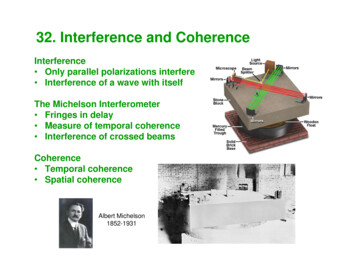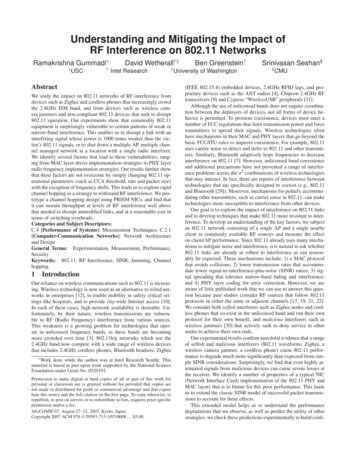
Transcription
Minimizing Interference and Maximizing Progress forHadoop Virtual MachinesWei Zhang*† , Sundaresan Rajasekaran* , Shaohua Duan* , Timothy Wood* and Mingfa Zhu†*Department of Computer Science, The George Washington University, Washington, D.C., USA†Beihang University, Beijing, ChinaABSTRACTVirtualization promised to dramatically increase server utilizationlevels, yet many data centers are still only lightly loaded. In someways, big data applications are an ideal fit for using this residualcapacity to perform meaningful work, but the high level of interference between interactive and batch processing workloads currentlyprevents this from being a practical solution in virtualized environments. Further, the variable nature of spare capacity may make itdifficult to meet big data application deadlines.In this work we propose two schedulers: one in the virtualizationlayer designed to minimize interference on high priority interactiveservices, and one in the Hadoop framework that helps batch processing jobs meet their own performance deadlines. Our approachuses performance models to match Hadoop tasks to the servers thatwill benefit them the most, and deadline-aware scheduling to effectively order incoming jobs. We use admission control to meetdeadlines even when resources are overloaded. The combinationof these schedulers allows data center administrators to safely mixresource intensive Hadoop jobs with latency sensitive web applications, and still achieve predictable performance for both. We haveimplemented our system using Xen and Hadoop, and our evaluation shows that our schedulers allow a mixed cluster to reduce webresponse times by more than ten fold compared to the existing XenCredit Scheduler, while meeting more Hadoop deadlines and lowering total task execution times by 6.5%.Keywordsscheduling, virtualization, Map Reduce, interference, deadlines,admission control1.INTRODUCTIONDespite the danger of interference, resource sharing through virtualization has been crucial for lowering the cost of cloud computing services. Multiplexing servers allows for higher average utilization of each machine, giving more profit for a given level of hardware expense. Yet the reality is that many data centers, even thoseemploying virtualization, are still unable to fully utilize each server.This is due in part to fears that if a data center is kept fully utilizedthere will be no spare capacity if workloads rise, and part due tothe risk of VM interference hurting performance even if servers areleft underloaded.In this paper, we first study the causes of interference throughvirtualization scheduler profiling. We observe that even when set tothe lowest possible priority, big data VMs (e.g., Hadoop jobs) interrupt interactive VMs (e.g., web servers), increasing their time spentin the runnable queue, which hurts response times. We control andreduce VM CPU interference by introducing a new scheduling priority for “background” batch processing VMs, allowing them torun only when other VMs are not actively utilizing the CPU.Our changes in the VM scheduler improve the performance ofinteractive VMs, but at the cost of unpredictable Hadoop performance. To resolve this challenge, we implement a second scheduler within the Hadoop framework designed for hybrid clusters ofdedicated and shared VMs that only use residual resources. Wefind that when given the same available resources, different taskswill progress at different rates, motivating the need to intelligentlymatch each Hadoop task to the appropriate dedicated or sharedserver. Our scheduler combines performance models that predicttask affinity with knowledge of job deadlines to allow Hadoop tomeet SLAs, despite variability in the amount of available resources.Together, these schedulers form the Minimal Interference Maximal Productivity (MIMP) system, which enhances both the hypervisor scheduler and the Hadoop job scheduler to better managetheir performance. Our primary contributions include:Virtualization has facilitated the growth of infrastructure cloudservices by allowing a single server to be shared by multiple customers. Dividing a server into multiple virtual machines (VMs)provides both a convenient management abstraction and resourceboundaries between users. However, the performance isolation provided by virtualization software is not perfect, and interference between guest VMs remains a challenge. If the hypervisor does notenforce proper priorities among guests, it is easy for one virtualmachine’s performance to suffer due to another guest. A new priority level built into Xen’s Credit Scheduler thatprevents batch processing VMs from hurting interactive VMperformance.This article is an extended version of [24], which appeared in CCGrid 2014 An admission control mechanism which ensures high priority jobs meet deadlines, even when a cluster is heavily overloaded.Copyright is held by author/owner(s).62 Task affinity models that match each Hadoop task to the dedicated or shared VM that will provide it the most benefit. A deadline and progress aware Hadoop job scheduler that allocates resources to jobs in order to meet performance goalsand maximize the efficiency of a hybrid cluster.We have implemented the proposed schedulers by modifying theXen hypervisor and Hadoop scheduler. Our evaluation shows thatPerformance Evaluation Review, Vol. 42, No. 4, March 2015
Normalized TCT1CDF0.80.6TPCW Alonew/PI Min Weightw/PI Def. Weightw/WC Min Weight0.40.200100200300400TPC-W Response Time (msec)76543210PiSort20500406080 100 120CPU Utilization140160180Figure 1: Colocated Hadoop jobs degrade web application performance, despite using the Xen scheduler priority mechanisms.Figure 2: TCT varies by job, and increases non linearly as the webservice consumes a larger quantity of CPU (out of 2 cores).MIMP can prevent nearly all interference on a web application,doubling its maximum throughput and providing nearly identicalresponse times to when it is run alone. For a set of batch jobs,the algorithm can meet more deadlines than EDF(Earliest DeadlineFirst), and reduces the total execution time by over four and a halfCPU hours, with minimal impact on interactive VM performance.Our paper is structured as follows: Section 2 provides the motivation of our paper, and Section 3 provides the problem and system overview for our work. In Section 4 and Section 5, we give adescription about interactive VM scheduling in Xen and progressaware deadline scheduling in Hadoop. Section 6 provides our evaluation using different benchmarks. We discuss related work in Section 7, and conclude in Section 8.TPC-W remains similar, as does the amount of CPU that it consumes. Further, we find that if Hadoop is given a separate CPUfrom TPCW, there is no interference at all. This suggests that theperformance interference is due to poor CPU scheduling decisions,not IO interference.A second major challenge when running in shared environmentsis that different Hadoop jobs are affected by limitations on availableresources in different ways. Figure 2 shows that as the amount ofresources consumed by a foreground interactive VM rises, the normalized task completion time (relative to Hadoop running alone)can increase significantly for some jobs. For example, Pi, a veryCPU intensive job, suffers more than Sort, which is IO intensive.As a result, the best performance will be achieved by carefullymatching a Hadoop job to the servers that will allow it to makethe most efficient progress.2.MAP REDUCE IN VIRTUALIZEDCLUSTERSMap Reduce is a popular framework for distributing data intensive computation [6]. Hadoop is an open source implementation ofMap Reduce developed by Yahoo. Users write a program that divides the work that must be performed into two main phases: Mapand Reduce. The Map phase processes each piece of input data andgenerates some kind of intermediate value, which is in turn aggregated by the Reduce phase.In this paper we investigate how to run Map Reduce jobs in a hybrid cluster consisting of both dedicated and shared (also knownas volunteer) nodes. This problem was first tackled by Clay etal., who described how to pick the appropriate number of sharednodes in order to maximize performance and minimize overall energy costs [5]. Like their work, we focus on scheduling and modeling the Map phase since this is generally the larger portion of theprogram, and is less prone to performance problems due to slownodes. Our work extends their ideas both within the virtualizationlayer to prevent interference, and at the Map Reduce job schedulinglevel to ensure that multiple jobs can make the best use of a hybridcluster and effectively meet deadlines.A key issue that has not yet been fully explored is how to preventbatch processing jobs such as Map Reduce from interfering withforeground workloads. Our results suggest that interference canbe quite severe if the important performance metric is interactivelatency as opposed to coarse grained timing measures (e.g., the timeto compile a linux kernel).As a motivating experiment, we have measured the achievedthroughput and response time when running the TPC-W onlinebook store benchmark both alone and alongside a VM runningHadoop jobs. Our results in Figure 1 show that the response timeof the web application can be dramatically increased when run witha Pi or WordCount (WC) job. This happens even when the Xenscheduler’s parameters are tuned to give Hadoop the lowest possible weight (i.e., the lowest priority). However, the throughput ofPerformance Evaluation Review, Vol. 42, No. 4, March 20153.PROBLEM AND SYSTEM OVERVIEWThis section presents the formal problem MIMP targets, and thengives an overview of the system.3.1Problem StatementThe scenario where we believe MIMP will provide the most benefit is in a hybrid cluster containing a mix of dedicated nodes (virtual or physical) and “volunteer” or “shared” nodes that use virtualization to run both interactive applications and Hadoop tasks.We assume that the interactive applications are higher priority thanthe Hadoop tasks, which is generally the case since users are directly impacted by slowdown of interactive services, but may bewilling to wait for long running batch processes. While we focuson web applications, the interactive applications could representany latency-sensitive service such as a streaming video server or remote desktop application. Although we treat Hadoop jobs as lowerpriority, we still take into account their performance by assumingthey arrive with a deadline by which time they must be complete.As discussed previously, we focus on the Map phase of MapReduce, as this is generally more parallelizable and is less proneto straggler performance problems (i.e., a single slow reduce taskcan substantially hurt the total completion time). As in [5], we usededicated servers to run both the shared Hadoop file system and allreduce tasks.We assume that the interactive applications running in the highpriority VMs have relatively low disk workloads, meaning that sharing the IO path with Hadoop tasks does not cause a resource bottleneck. While this is not true for some disk intensive applicationssuch as databases, for others it can be acceptable, particularly dueto the increasing use of networked storage (e.g., Amazon’s ElasticBlock Store) rather than local disks.Given this type of cluster, a key question is how best to allocate the available capacity in order to maximize Hadoop job per-63
MI bAppHadoopTaskTrackerWebAppHadoopTask TrackerHadoopData NodeHadoopMP JobSchedulerResourceMonitorMP ockedVM-1VM-2.MI CPU SchedulerMI CPUSchedulerXenXenXenAdmissioncontrolShared ServerShared ServerDedicated ServerTask SchedulerFigure 3: The MI CPU scheduler only runs Hadoop VMs when others are blocked, so VM-2 immediately preempts VM-3 once it becomesready. The MP Job Scheduler gathers resource availability information from all nodes and schedules jobs based on performance modelresults.TPC-W 600 clientsAvg. Resp. TimeAvg. CPU UtilizationRunning (sec)Runnable (sec)Blocked (sec)formance (i.e., minimize the number of deadline misses and the total job completion times) while minimizing the interference on theinteractive services (i.e., minimizing the change in response timecompared to running the web VMs alone).3.2MIMP OverviewWe have developed MIMP to tackle this pair of challenges. Thesystem is composed of two scheduling components, as illustratedin Figure 3.Minimal Interference CPU Scheduler: The MI CPU Scheduler tries to prevent lower priority virtual machines from takingCPU time away from interactive VMs. We do this by modifyingthe Xen CPU scheduler to define a new priority level that will always be preempted if an interactive VM becomes runnable.Maximal Productivity Job Scheduler: Next we modify theHadoop Job scheduler to be aware of how available resources affects task completion time. The MP Scheduling system is composed of a training module that builds performance models, a monitoring system that measures residual capacity throughout the datacenter, and a scheduling algorithm. Our MP Scheduler combinesthis information to decide which available resources to assign toeach incoming Hadoop Job to ensure it meets its deadline whilemaking the most productive use of all available capacity.4.VM SCHEDULING IN XENThis section diagnoses the performance issues in the Xen currentCredit scheduler when mixing latency sensitive and computationally intensive virtual machines. We then describe how we haveenhanced the Xen scheduler to help minimize this interference.4.1Performance with Xen Credit SchedulerXen Credit scheduler is a non-preemptive weighted fair-sharescheduler. As a VM runs, its VCPUs are dynamically assigned oneof three priorities - over, under, or boost, ordered from lowest tohighest. Each physical CPU has a local run queue for runnable VCPUs, and VMs are selected by their priority class. Every 30ms, asystem-wide accounting thread updates the credits for each VCPUaccording to its weight share and resorts the queue if needed. Ifthe credits for a VCPU are negative, Xen assigns “over” priority tothis VCPU since it has consumed more than its share. If the creditsare positive, it is assigned “under” priority. Every 10ms, Xen updates the credits of the currently running VCPU based on its running time. In order to improve a virtual machine’s I/O performance,if a VCPU is woken up (e.g., because an IO request completes) andit has credits left, it will be given “boost” priority and immediatelyscheduled. After the boosted VCPU consumes a non-negligibleamount of CPU resources, then Xen resets the priority to “under”.As this is a weight-based scheduler, it primarily focuses on allocating coarse grained shares of CPU to each virtual machine. The64Alone25 msec84.8%605.91.91092.4 WC (min weight)175.5 msec91.1%656.4524.4520.2Table 1: Xen Credit Scheduler statistics when running a web application alone or with a Word Count VM.Boost mechanism is relied upon to improve performance of interactive applications, but as shown previously, it has limited effect.Table 1 shows how much time was spent in each scheduler statewhen a TPCW VM is run either alone or with a VM running theWord Count Hadoop job that has been given the lowest possiblescheduler weight. As was shown in Figure 1, this significantly affects TPCW performance, raising average response time by seventimes. We find that the Credit Scheduler weight system does do agood job of ensuring that TPCW gets the overall CPU time that itneeds—the CPU utilization (out of 200% since it is a 2-core machine) and time spent in the Running state are similar whether TPCW is run alone or with word count. In fact, TPC-W actually getsmore CPU time when run with word count, although the performance is substantially worse. While the overall CPU share is similar, the timeliness with which TPC-W is given the CPU becomesvery poor when word count is also running. The time spent in theRunnable state (i.e., TPC-W could be servicing requests) rises substantially, causing the delays that increase response time.This happens because Credit uses coarse grain time accounting,which means that 1) at times TPC-W may be woken up to handleIO, but it is not able to interrupt Hadoop; and 2) at times Hadoopmay obtain boost priority and interrupt TPC-W if it is at the beginning of an accounting interval and has not yet used up its quantum.4.2Minimal Interference CPU SchedulerOur goal is to run processor or data intensive virtual machines inthe background, without affecting the more important interactiveservices. Therefore, we have modified the Xen scheduler to definea new extra low priority class. Virtual machines of this class arealways placed at the end of the Runnable queue, after any higherpriority VMs. We also adjust the Boost priority mechanism so that“background” VMs can never be boosted, and so that if a regularVM is woken up due to an I/O interrupt, it will always be able topreempt a background VM, regardless of its current priority (i.e.,under or over).This scheduling algorithm minimizes the potential CPU interference between interactive and Hadoop virtual machines, but it cancause starvation for background VMs. To prevent this, we allow aperiod, p, and execution time, e, to be specified. If over p secondsthe VM has not been in the Running state for e milliseconds, thenPerformance Evaluation Review, Vol. 42, No. 4, March 2015
its priority is raised from background to over. After it is scheduledfor the specified time slice, it reverts back to background mode.We use this to ensure that Hadoop VMs do not become completelyinaccessible via SSH, and so they can continue to send heartbeatmessages to the Hadoop job scheduler. While this mechanism isnot necessary when running interactive VMs that typically leavethe CPU idle part of the time, it can be important if MIMP is runeither with CPU intensive foreground tasks, or with a very largenumber of interactive VMs.5.PROGRESS AWARE DEADLINESCHEDULING IN HADOOPCompletableT asks(j, R) Modeling Background Hadoop JobsMIMP uses Task Completion Time models to predict the progressrate of different job types on a shared node with a given level of resources. As shown previously in Figure 2, each job needs its owntask completion time model. The model is trained by running maptasks on shared nodes with different available CPU capacities. Thiscan either be done offline in advance, or the first set of tasks for anew job can be distributed to different nodes for measurement, andthen a model can be generated and updated as tasks complete. Ourcurrent implementation assumes that all jobs have been trained inadvance on nodes with a range of utilization levels. Once a jobhas been trained for one data input size, it can generally be easilyscaled to accurately predict other data sizes [17].Job Progress: The progress model for a job of type j is a function that predicts the task completion time on a shared node withresidual capacity r. From Figure 2 we see that this relationship ishighly non-linear, so we use a double exponential formula, exp2,provided by MATLABs Non-linear Least Squares functionality :T CTj (r) a eb r c ed r(1)where a, b, c, and d are the coefficients of the regression modeltrained for each job. The coefficients b and d represent the rateat which T CTj (r) exponentially grows. In order to compare theprogress that will be made by a job on an available slot, we use thenormalized TCT:N ormT CTj (r) T CTj (r)T CTj (rdedicated )(2)where the denominator represents the task completion time whenrunning on a dedicated node. This allows MIMP to compare therelative speeds of different jobs.Performance Evaluation Review, Vol. 42, No. 4, March 2015nXslot i 1A Hadoop Job is broken down into multiple tasks, which eachperform processing on a small part of the total data set. When runon dedicated servers, the total job completion time can be reliablypredicted based on the input data size and previously trained models [25, 17]. The challenge in MIMP is to understand how jobcompletion times will change when map tasks are run on serverswith variable amounts of spare capacity. Using this information,MIMP then instructs the Hadoop Job Tracker on how to allocate“slots” (i.e., available shared or dedicated workers) to each job.Monitoring Cluster Resource Availability: MIMP monitorsresource usage information on each node to help guide task placement and prevent overload. MIMP runs a monitoring agent on eachdedicated and shared node, and sends periodic resource measurements to the centralized MP Job Scheduler component. MIMPtracks the CPU utilization and disk read and write rates of eachvirtual machine on each host. These resource measurements arethen passed on to the modeling and task scheduling components asdescribed in the following sections.5.1Checking Deadlines: The task completion time model can thenbe used to determine if a job will be able to meet its deadline givenits current slot allocation. MIMP tracks a resource vector, R, foreach active job. The entry Ri represent the amount of resourcesavailable on worker slot i that this job has been allocated for use:100% for an available dedicated slot, 0% for a slot assigned to adifferent job, or something in between for a shared slot allocatedto this job. If there is currently tremaining seconds until the job’sdeadline, then MIMP can check if it will meet its deadline using:tremainingT CTj (Ri )(3)If CompletableT asks(R) is greater than ntasks , the number ofremaining tasks for the job, then it is on track to meet its deadline.Map Phase Completion Time: We can also obtain a direct prediction of the map phase completion time using:CompletionT ime(j, R) ntasksnXT CTj (Ri )n(4)slot i 1which estimates the total map phase completion time based on theaverage TCT of each slot and the number of remaining tasks.Data Node I/O: Hybrid clusters like the ones considered in MIMPare particularly prone to disk I/O bottlenecks since there may be arelatively small number of dedicated nodes acting as the data store.If too many I/O intensive tasks are run simultaneously, task completion times may begin to rise [5]. To prevent this, we use a modelto predict the I/O load incurred by starting a new map task. DuringMIMP model training phase, we measure the read request rate sentto the data nodes by a dedicated worker. Since I/O accesses canbe erratic during map tasks, we use the 90th percentile of the measured read rates to represent the I/O required by a single worker,per data node available. In order to calculate the read I/O load incurred by a new task on a shared worker, we use the normalizedTCT from Equation 2 as a scaling factor:thIOj (r) read90jN ormT CTj (r)(5)to predict its I/O requirement. This can then be used to determinewhether running the task will cause the data nodes to become overloaded, as described in the following section.5.2Progress Aware Earliest Deadline FirstWe now present two standard Hadoop job schedulers, and thendiscuss how we enhance these in MIMP so that it accounts for bothdeadlines and the relative benefit of assigning a worker to each job.FIFO Scheduler: The simplest approach to scheduling Hadoopjobs is to service them in the order they arrive—all tasks for the firstjob are run until it finishes, then all tasks of the second job, and soon. Not surprisingly, this can lead to many missed deadlines sinceit has no concept of more or less urgent tasks to perform.EDF Scheduler: Earliest Deadline First (EDF) is a well knownscheduling algorithm that always picks the job with the earliestdeadline when a worker becomes available; that job will continueto utilize all workers until it finishes or a new job arrives with asmaller deadline. EDF is known to be optimal in terms of preventing deadline misses as long as the system is preemptive andthe cluster is not over-utilized. In practice, Hadoop has somewhatcoarse grained preemption—each task runs to completion, but ajob can be preempted between tasks. It is also difficult to predictwhether a Hadoop cluster is over-utilized since tasks do not arrive65
Job SubmissionAdmissionControlRejectedAcceptedJob QueueSchedulerDeadlineAwareMiss DeadlineAll MeetDeadlineEarliest DeadlineTaskTrackerTo prevent a cluster from becoming overloaded, we present Admission Control mechanism in MIMP scheduler. The AdmissionControl maximizes the number of jobs that can meet their deadlines by accepting or rejecting a new incoming job to be executedin the cluster based on whether or not it will overload the resourcesof that cluster.We assume that jobs with earlier deadlines always have the highest priority. This means that if a new job arrives with an earlierdeadline than some job already in the queue, it may be acceptedeven though this could cause the job in the queue may now miss itsdeadline. A job will only be accepted into the queue if MIMP predicts it can meet its deadline with the available resources.We designthe admission controller based on the following criteria:ProgressAware When a new job Jnew with deadline Deadlinenew is submitted, the controller finds the jobs J1 , J2 , . . . , JN in the jobprocessing queue that have an earlier deadline than Jnew .For instance, if J1 and J2 are the only jobs that have an earlier deadline than Jnew , then the controller will find the jobsJ1 , J2 , Jnew to be evaluated. Remember that we assume thejobs Jnew 1 , Jnew 2 , ., JN will meet their deadlines.Max ProgressTaskTrackerFigure 4: Admission Control Architecture In order to accept Jnew , MIMP must determine if doing sowill cause any higher priority job (i.e., one with an earlierdeadline) to miss its deadline. The Admission Controllerdoes this by estimating the processing time required by eachhigher priority job. To make a conservative estimate, we calculate each job’s estimated completion time assuming it runsby itself on the cluster, using equation 6. In practice, MIMPwill be progress-aware, and will attempt to assign each jobto its most efficient slots, so it is likely that this will be anoverestimate; this makes the admission controller more conservative, reducing the likelihood of a missed deadline.on strict schedules as is typically assumed in Real Time OperatingSystems work. Despite this, we still expect EDF to perform wellwhen scheduling jobs since it will organize them to ensure they willnot miss deadlines.MP Scheduler: Our Maximum Progress (MP) Scheduler usesthe models described in the previous section to enhance the EDFscheduler. Whenever a worker slot becomes free, we determinewhich job to assign to it based on the following criteria. First, MP examines each job in the queue to determine whetherit can meet its deadline with its currently allocated set of slotsusing Equation 3. If one or more jobs are predicted to misstheir deadline, then MP allocates the slot to whichever ofthose jobs has the closest deadline and returns.JCT (j, R) ntask remainingThis algorithm ensures that the selected job is either currentlyunable to meet its deadline, or the job that will make the mostprogress with the slot, without causing the data nodes to becomeoverloaded.5.3Admission-ControlHigh number of incoming jobs can cause the cluster resources tobe overloaded. When cluster resources are over-utilized, naturally,due to resource contention, we will have more jobs that will misstheir deadlines than usual. EDF scheduler does not have a mechanism that can control resource overload, instead, it tries to scheduleas many jobs at it can fit in the incoming job queue. This aggressive approach not only can make a new job miss the deadline butcan also cause other jobs in the queue to miss their deadlines aswell.66(6)slot i 1 Once we estimate the processing time, the Admission Controller accepts the new job if and only if all the jobs that hastheir deadlines lesser than Deadlinenew can complete successfully. The acceptance condition for a new job is shownin equation 7. If this condition is not met, there is a high probibility that some jobs will miss their deadlines and we thusreject Jnew . If all jobs are currently able to meet their deadlines, MP considers each job in the queue and uses Equation 2 to calculateits normalized task completion time if assigned the resourcesof the free slot. It finds the job with the smallest normT CTvalue, since that job is best matched for the available resources. Before assigning the slot, MP calculates the IO cost of running the selected job using Equation 5. If starting a new taskof this type will cause any of the data nodes to become overloaded, then the job with the next highest normT CT is considered, and so on.nXT CTj (Ri )n2DeadlinenewnewXJCTi(7)job i 1Figure 4 shows the decision making process of our MIMP scheduler with Admission Control. First, when a new job is submitted,the admission controller, based on the above criteria predicts thenew jobs completion time and then makes a decision whether toaccept or reject the job. In the case where a job is accepted, thenewly accepted job would then be put into a job processing queuewhere it waits to get scheduled. When the scheduler finds somefree task slots that free up, it allocates those free slots to the jobs inthe queue based on deadline-aware or progress-aware scheduling.Finally, once the free slots are allocated to the jobs, they are run ontheir assigned task trackers.6.EVALUATIONIn this section, we present the evaluation results to validate theeffectiveness of reducing interference using our Minimizing Interference Scheduler. We then evaluate the accuracy and predictionPerformance Evaluation Review, Vol. 42, No. 4, March 2015
Setup - machines, benchmarks6.2Minimizing Interference SchedulerWe start our evaluation by studying how our Minimal Interference Scheduler is able to provide greater performance isolationwhen mixing web and processor intensive tasks. We repeat a variation
Minimizing Interference and Maximizing Progress for Hadoop Virtual Machines Wei Zhang *†, Sundaresan Rajasekaran , Shaohua Duan , Timothy Wood and Mingfa Zhu† *Department of Computer Science, The George Washington University, Washington, D.C., USA †Beihang University, Beijing, China ABSTRACT Virtualization promised to dramatically increase server utilization










